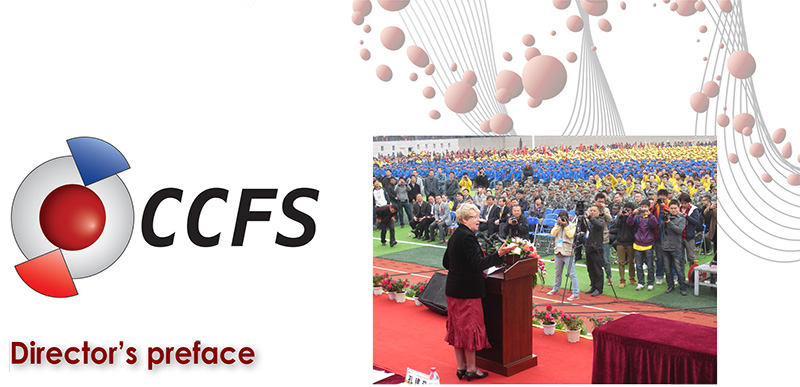
Sue O’Reilly addressing the large crowd at the celebration of 60th Anniversary of the founding of the China University of Geosciences, Wuhan.
This report summarises the activities of the Australian Research Council Centre of Excellence for Core to Crust Fluid Systems (CCFS) in 2012 (commenced mid 2011) in accordance with ARC requirements. Activities include research, technology development, industry interaction, international links and research training.
The overarching goal of CCFS is to understand Earth’s internal dynamics, evolution and fluid cycles from core to crust. CCFS multiplies the capabilities of three national centres of research excellence in Earth and Planetary Sciences: Macquarie University (Administering Institution), Curtin University and the University of Western Australia (Collaborating Institutions). The Geological Survey of Western Australia is a Partner Institution and researchers from Monash University and the University of New South Wales are formally affiliated.
There are five formal international nodes led by Partner Investigators in France (University of Montpellier), China (Institute of Geology and Geophysics, China Academy of Sciences), Canada (University of Saskatchewan), Germany (Bayreuth University) and the USA (University of Maryland). However, since CCFS commenced, international interaction has blossomed and now includes active projects with 94 international institutions, with 150 international collaborators as co-authors on research articles in 2012. These international collaborations are contributing resources and provide access to a wide variety of complementary expertise, logistics and instrumental capabilities.
CCFS builds on pre-existing centres within the Administering and Collaborating Institutions: the GEMOC Key Centre (http://www.gemoc.mq.edu.au/) at Macquarie University retains its structure and is fully incorporated within CCFS to capitalise on its global recognition; the research and strategic activities of the Centre for Exploration Targeting (http://www.cet.edu.au/) at the University of Western Australia lie within CCFS; and the activities of TiGeR (http://tiger.curtin.edu.au/) at Curtin University are also aligned with CCFS.
A highlight of 2012 was the joint Research Meeting held as part of the visit of the Science Advisory Council (SAC) in August 2012. The SAC presented a comprehensive report praising the Centre structure and activities and providing some very constructive suggestions. Some extracts illustrate the views:
“Advisory Council members considered the standard of presentations to be excellent, and they produced several enthralling sessions….”
“The CCFS Is already doing an excellent job at portraying a “corporate identity”, carrying on the fine tradition of the GEMOC group”
“The nodes of the CCFS together form a major, world-leading centre in the in-situ microanalysis of trace elements and isotopes in minerals metal concentrations,”
Recruitment and mentoring of early- and mid-career researchers is a high-level goal in CCFS: early-career researchers and the six Future Fellows are highlighted in the Participants section. Research training has expanded rapidly: there are now 69 PhD students undertaking projects aligned with CCFS and Macquarie University has introduced a revolutionary Masters Research (MRES) program commencing 2013 that will be the vehicle for many CCFS research training goals. Four inaugural units directly deliver CCFS related research training and are also being developed as portable short courses.
CCFS is rapidly expanding – including the number of researchers (especially early- to mid-career), postgraduate students, international links, and research horizons. The Research highlights in this report evidence a high level of activity with exciting frontline scientific outcomes.
We look forward to an exciting year of new discoveries bringing another level of challenging scientific endeavours, towards better understanding the structure, composition and dynamics of our home planet, Earth, and its geological evolution ”from core to crust” over 4.5 billion years – ultimately the pathway to securing Australia’s future mineral security and ensuring economic health for our society.
Profesor S.Y. O'Reilly

 ARC Centre of Excellence for Core to Crust Fluid Systems
ARC Centre of Excellence for Core to Crust Fluid Systems